Abstract
OBJECTIVES: Hair bleaches containing persulphates have been identified as the cause of occupational asthma in hairdressers. Also employees in persulphate production with occupational asthma have been described. It was the aim of this study to give an estimate of the prevalence of asthma due to persulphates in chemical workers with exposure to ammonium and sodium persulphate. METHODS: A cross sectional study was performed in 32 of 33 employees of a persulphate producing chemical plant. Eighteen of 23 workmen from the same plant with no exposure to persulphates were taken as controls. Also, information was collected from medical records of the seven subjects who had left the persulphate production for medical reasons since 1971. Data were recalled by a questionnaire, skin prick tests were performed with five environmental allergens, and ammonium and sodium persulphate (80 mg/ml). Specific immunoglobulin E (IgE) to the same environmental allergens as in the skin test, and total IgE were measured. Lung function and bronchial responsiveness to histamine were assessed by standard procedures. Workplace concentrations of ammonium and sodium persulphate were estimated by area and personal monitoring. The amount of persulphate was analysed as sulphur by inductively coupled plasma emission spectrometry. RESULTS: Work related rhinitis was reported by one subject with exposure to persulphates, conjunctivitis and bronchitis were reportedly related to work by two controls. There were no cutaneous reactions to persulphates in either group. Four non-atopic subjects exposed to persulphates, and two controls, one atopic and one non-atopic, were considered to be hyperresponsive to histamine. Three subjects exposed to persulphates with bronchial hyperresponsiveness (provocation dose of histamine causing a 15% fall in forced expiratory volume in one second (PD15 FEV1) < or = 1 mg) did not show variability in peak expiratory flow of > or = 20%, the rest refused peak flow measurements. None of the variables showed significant differences between the groups (P > 0.05). Six of the exworkers left because of work related contact dermatitis. Mean values for workplace concentrations of ammonium and sodium persulphate within the bagging plant were below 1 mg/m3, and the maximal concentrations were 1.4 mg/m3 and 3.6 mg/m3, respectively. CONCLUSION: Exposure to workplace concentrations of ammonium and sodium persulphate of about 1 mg/m3 in this chemical plant was not associated with a risk of occupational asthma.
Full text
PDF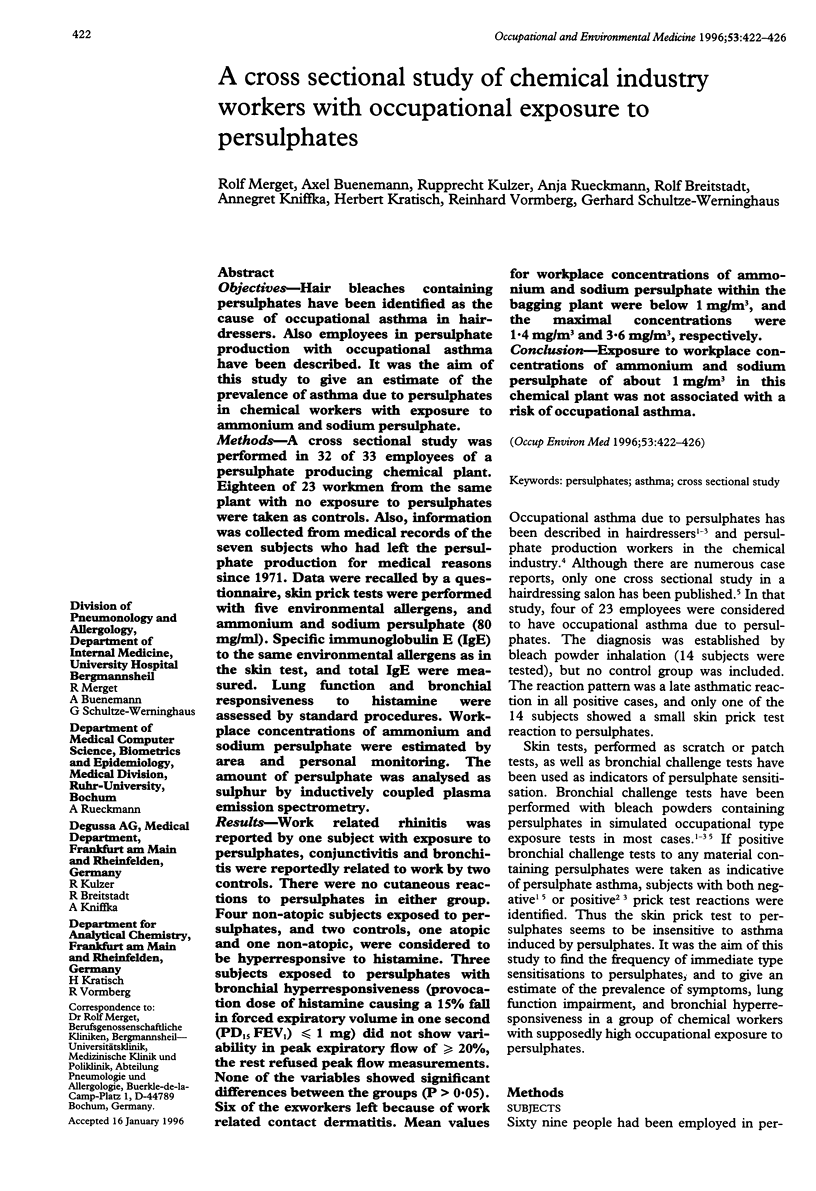
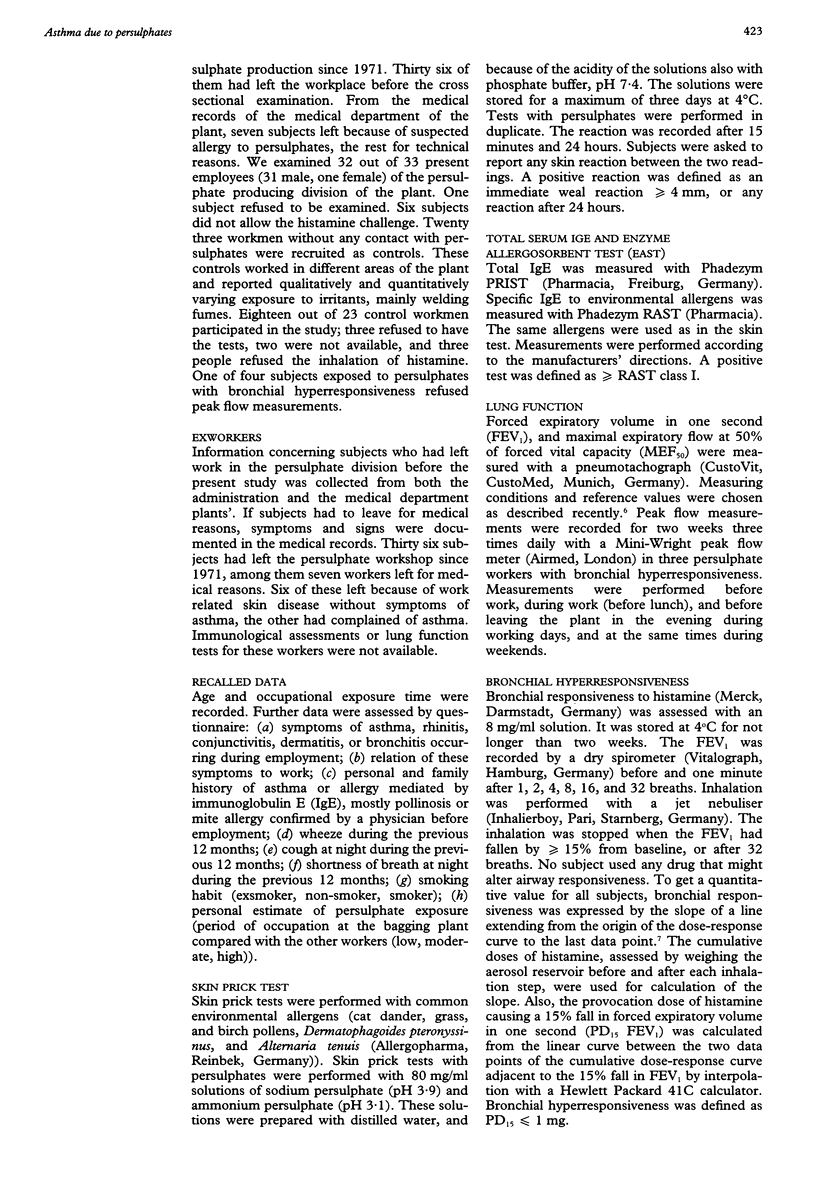
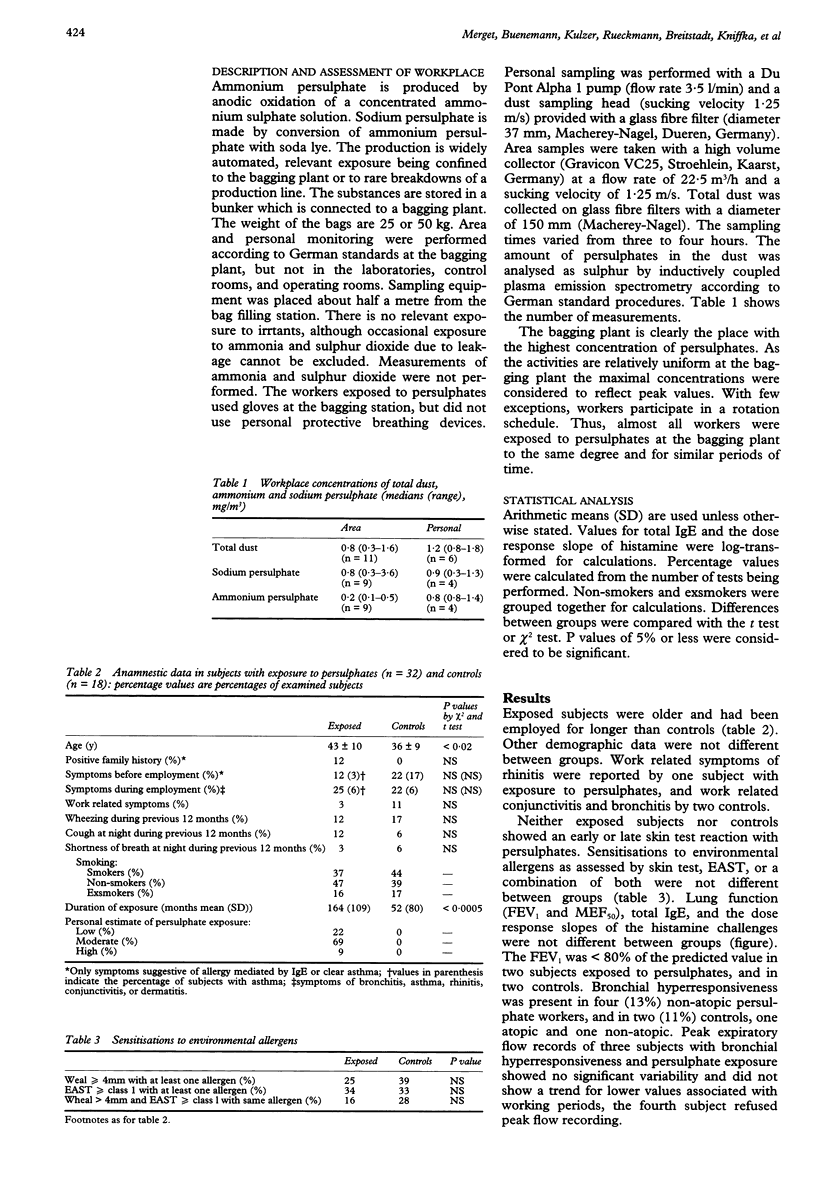
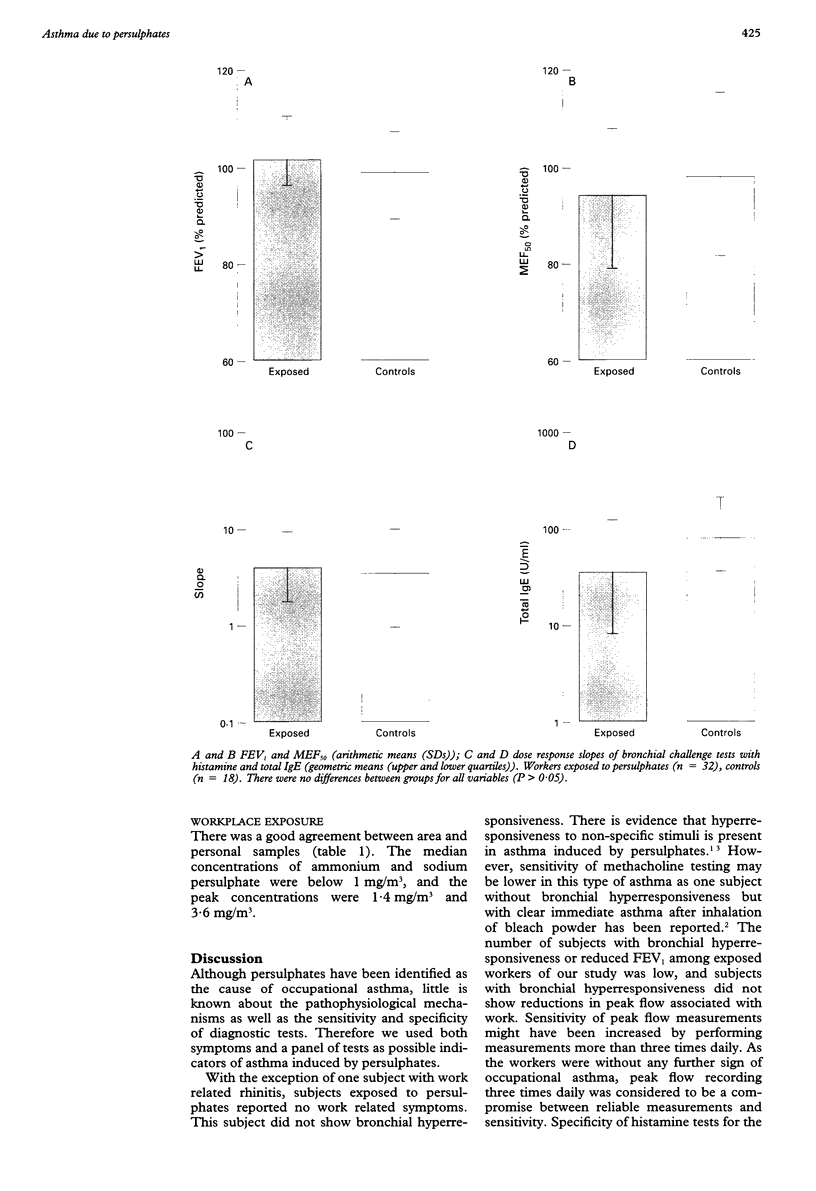
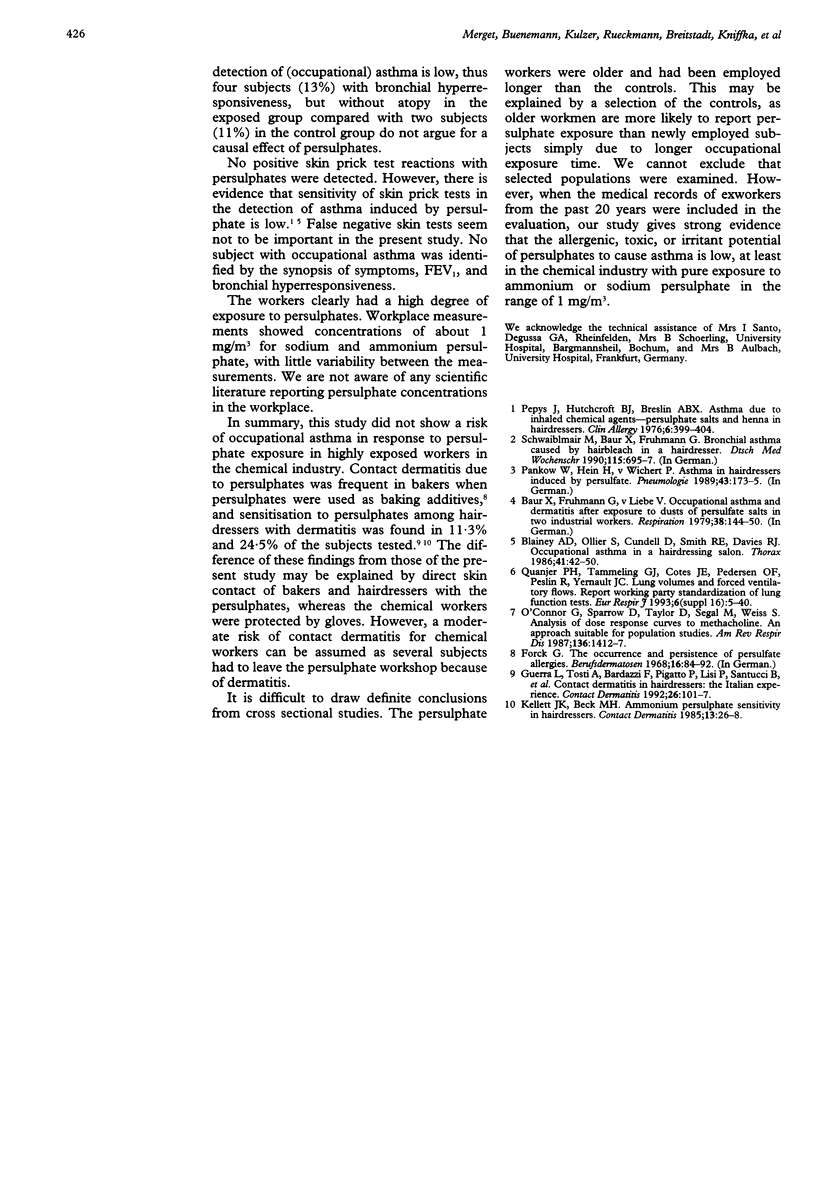
Selected References
These references are in PubMed. This may not be the complete list of references from this article.
- Blainey A. D., Ollier S., Cundell D., Smith R. E., Davies R. J. Occupational asthma in a hairdressing salon. Thorax. 1986 Jan;41(1):42–50. doi: 10.1136/thx.41.1.42. [DOI] [PMC free article] [PubMed] [Google Scholar]
- Forck G. Vorkommen und Persistenz von Persulfatallergien. Berufsdermatosen. 1968 Apr;16(2):84–92. [PubMed] [Google Scholar]
- Guerra L., Tosti A., Bardazzi F., Pigatto P., Lisi P., Santucci B., Valsecchi R., Schena D., Angelini G., Sertoli A. Contact dermatitis in hairdressers: the Italian experience. Gruppo Italiano Ricerca Dermatiti da Contatto e Ambientali. Contact Dermatitis. 1992 Feb;26(2):101–107. doi: 10.1111/j.1600-0536.1992.tb00892.x. [DOI] [PubMed] [Google Scholar]
- Kellett J. K., Beck M. H. Ammonium persulphate sensitivity in hairdressers. Contact Dermatitis. 1985 Jul;13(1):26–28. doi: 10.1111/j.1600-0536.1985.tb02487.x. [DOI] [PubMed] [Google Scholar]
- O'Connor G., Sparrow D., Taylor D., Segal M., Weiss S. Analysis of dose-response curves to methacholine. An approach suitable for population studies. Am Rev Respir Dis. 1987 Dec;136(6):1412–1417. doi: 10.1164/ajrccm/136.6.1412. [DOI] [PubMed] [Google Scholar]
- Pankow W., Hein H., Bittner K., Wichert P. Persulfat-Asthma im Friseurberuf. Pneumologie. 1989 Mar;43(3):173–175. [PubMed] [Google Scholar]
- Pepys J., Hutchcroft B. J., Breslin A. B. Asthma due to inhaled chemical agents--persulphate salts and henna in hairdressers. Clin Allergy. 1976 Jul;6(4):399–404. doi: 10.1111/j.1365-2222.1976.tb01922.x. [DOI] [PubMed] [Google Scholar]
- Quanjer P. H., Tammeling G. J., Cotes J. E., Pedersen O. F., Peslin R., Yernault J. C. Lung volumes and forced ventilatory flows. Report Working Party Standardization of Lung Function Tests, European Community for Steel and Coal. Official Statement of the European Respiratory Society. Eur Respir J Suppl. 1993 Mar;16:5–40. [PubMed] [Google Scholar]
- Schwaiblmair M., Baur X., Fruhmann G. Asthma bronchiale durch Blondiermittel im Friseurberuf. Dtsch Med Wochenschr. 1990 May 4;115(18):695–697. doi: 10.1055/s-2008-1065068. [DOI] [PubMed] [Google Scholar]


